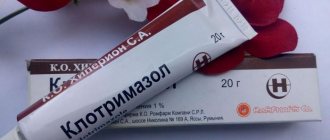Characteristics of the drug
Clotrimazole belongs to the pharmacotherapeutic category of antifungal agents. In gynecology it is used locally.
Indications:
Release forms
Clotrimazole has several varieties.
Main types:
Main active ingredient
Application
According to the official instructions, Clotrimazole is used intravaginally (introduced into the vagina).
Daily dosage:
Clotrimazole is administered at night.
When taking medication, it is recommended to follow the instructions:
Contraindications
The product is contraindicated:
Forms intended for intravaginal use should not be used during menstruation.
Side effects
The main negative manifestations of Clotrimazole in the form of cream and tablets:
According to the annotation for the drug, the use of vaginal suppositories can cause the following side effects:
clotrimazole menstruation
It all probably started at birth. Then it was true that they were small red pimples/dots. As we were told at the clinic, it’s just “transitional.” Well, she ate almost everything, and didn’t know about blood pressure (she herself suffered from “diathesis” as a child).
At 3 months , after a walk in cold air (0 degrees, first frosts), the cheeks became flushed. So for a month we thought that we were weathered/frozen.
Seborrheic dermatitis appeared - the head was covered in scales. It was quickly cured with mustela.
There were also bright rashes in the neck, groin folds and armpits. I was treated by a dermatologist with talkatives, sudocrem, and clotrimazole.
At 4 months our blood pressure is diagnosed. No treatment, just diet. Now I understand that the pediatric diet is not a diet at all, but a whole celebration of the belly. Sour milk and bread, fish, etc. were allowed. So they lasted almost until the New Year. When it got really bad (not only my cheeks, but also my arms and legs), the pediatrician put me on a stricter diet, without fish or sour milk. And 10 days on Advantan + fenistil. In general, I ate buckwheat, pasta, bread, potatoes, rice... I don’t remember what else was there. 10 days and everything is great. As soon as Advantan was stopped, everything turned red with terrible force.
5 months On December 29, we went to hospital No. 14, where the director received us, we were prescribed a course of treatment: naphthalan paste and UNNA cream (both were given there, home-made), bluing for the lesions, diet (again, cottage cheese, cheese, goat cheese are allowed milk). Suprostin. Enterosgel.Calcium. All for 10 days (but smeared longer). We tried it and the result was zero. The condition changed two after two. Sometimes it’s easier, sometimes it’s worse. In general, no move.
The only thing is that they began to bathe every other day and for 5 minutes, the skin (except for the lesions) became soft.
6 months . At the end of January we have an appointment with our pediatrician: we continue to apply Unna, Tsindol, Depanthenol, Advantan (according to her, you can apply it for a month, or even 3 in a row). All sorts of ointments to choose from, I didn’t prescribe an exact course. Wet spots appeared on the arm and leg, and they were removed instantly with blue. The menu is varied: corn, potatoes, broccoli, goat milk, brown bread, prunes, apple, pork, turkey, rabbit, rice, salad, herbal tea for children, black, millet porridge, pasta, barley porridge, rye flour, wheat flour, zucchini , zucchini, onions, dill, cookies, I tried fish once (I seemed to have a reaction to it). I stopped taking buckwheat. On February 12 I tried sheep's milk - I was flushed and itchy. I removed it.
We submitted the poop for scatology, dysbak and carbohydrates, and here are the deviations from the norm:
mucus - in large quantities
neutral fat - in moderate quantities
Escherichia coli with weakly expressed enzymes - 100%
Staphylococcus (epid) epidermidis — 67%
carbohydrates 1%
Comments on the analyzes of the pediatrician and dermatologist: nothing critical.
7 months . After a month's course, Advantan was discontinued, and at the same time, complementary feeding of cauliflower (BL) was introduced. After 3 days, severe redness and itching all over the body. There are new lesions and flaky crusts on the arms and legs. There are yellow crusts on the cheeks.
February 28: Visit to the pediatrician: insists on complementary feeding. I haven't entered it yet.
I went to see a dermatologist: Bepanthen. They smeared it, my cheeks, chin and under my eyes became red and itched badly. I removed the bepanten.
March 2 Visit to the dermatologist: Zodak 5 drops - 1 time per day, Emolium (I apply 2-3 times per day), Sudocrem 1 time per day on the lesions (10 days) at night.
February 28 new menu:
potatoes, pork, plain cabbage, zucchini, rabbit, rice, apple (sometimes), olive oil.
Since March 8, I have only left rice, rabbit (fresh and BL), olive oil, potatoes (soaked, sometimes).
Result: significant softening of the skin. He turned pale. Finally feeling better!!! Redness occurs after a walk, or while crying. It was as itchy as it was. Cheeks scratch at night, legs and arms, stomach scratches during the day.
On March 11, a visit to a gastroenterologist, based on the results of winter tests, she prescribed: Lactobacterin - 1 ampoule per day (3 days), then + 1 ampoule per day (3 days), then + 1 ampoule per day. Lactase baby 1 capsule with food. She ordered complementary foods to be introduced and the interval between feedings to be increased to 3 hours (currently 1-1.5 hours).
On March 10th I ate buckwheat.
On March 11, I consumed a teaspoon of sugar. Turned pink.
March 12 tsp sugar. A bottle of LACTOBACTERIN By the evening, our cheeks, arms, legs, stomach and even my butt are burning!!!!
An attempt to introduce barley flour failed (((
Three days before the trip, Beloslava’s skin looked quite decent.
We flew to Turkey on March 31, and already on the plane I ate a set of “forbidden” foods, and upon arrival I also threw in another portion of “allergens.” The child had no reaction.
True, it came out a couple of times, on an egg, and maybe on a fish.
Now it’s May 15th, we haven’t had any spots for two weeks now, the itching has almost disappeared, the rough spots are slightly visible. It's clearly getting better.
The food is varied, I can afford to eat a piece of chocolate, a donut, a cheburek, I drink goat’s milk, etc.
They donated blood, urine - everything is fine, feces for scatology - here again there is dysbiosis. But I don’t want to give dietary supplements like primadophilus and so on, I have no faith in them, and I don’t want to experiment.
Causes and nature of discharge
Treatment with the drug depends on the characteristics of the female body and the individual reaction to the medicine.
After Clotrimazole, discharge may occur due to various circumstances.
Main reasons
Most often, the basis for the discharge of leucorrhoea from the vagina is the composition of the drug. In addition to the active substance - clotrimazole, the product contains components that promote the absorption of the drug on the mucous membrane. The therapeutic effect of Clotrimazole consists of partial absorption of the main substance and removal of the remains of the suppository or tablet from the vagina in the form of secretions.
The nature and color of the leucorrhoea depends on the correct use of the drug . If the instructions for use of Clotrimazole are not followed, secondary infection is possible, one of the manifestations of which is characteristic discharge.
The causes of leucorrhoea also depend on the period of occurrence of the discharge:
Hormonal instability can also cause leucorrhoea.
Nature of the discharge
Normally, vaginal leucorrhoea looks like clear mucus. Their consistency depends on the individual menstrual cycle, so the discharge can be thin or thick. In a healthy woman, the smell of leucorrhoea is either absent or weak, pleasant.
The leucorrhoea released after Clotrimazole can have different colors: pink, white, yellowish, or be bloody. Particular attention should be paid to the appearance of discharge in pregnant women.
Pink discharge
The reasons for pink-colored discharge may lie in the mechanism of action of the drug. After inserting the suppository into the vagina, the active substance, clotrimazole, penetrates the mucosal cell affected by the fungus. As a result of the fungal process, the vascular permeability of the inflamed vaginal walls is increased, so Clotrimazole can cause rupture of small capillaries, which leads to pink or bloody discharge.
Taking this into account, after Clotrimazole, pink discharge that occurs within 1-3 days from the start of treatment is considered a normal symptom. Such manifestations should not last long, after which the discharge becomes transparent, white or acquires a creamy tint. This means that the drug has the desired effect and the task of destroying the fungus will be completed.
If, after consuming suppositories, there is excessive bleeding and there are other alarming symptoms, you should consult a gynecologist. Bleeding can be caused by pathological changes in the cervix. In this case, erosive manifestations and microcracks may bleed under the influence of the drug.
White discharge
Such a manifestation, not accompanied by other painful symptoms, is considered the body’s reaction to the suppository. A certain part of the substances contained in the drug is released.
If the white discharge has a cheesy appearance, it is recommended to consult a doctor. This symptom may characterize the insufficiency of antifungal therapy with Clotrimazole and indicate the need for complex treatment.
Yellow secret
Yellow discharge after Clotrimazole may be associated with the use of vaginal tablets or suppositories. The rest of the drug comes out.
Clotrimazole: pink discharge, causes and solutions to the problem
- 1 Reasons for the appearance of discharge
- 2 Diagnostics
- 3 Treatment
Violation of the vaginal microflora and the development of fungal infections cause a woman great discomfort. Today, such pathologies are effectively treated with antifungal drugs for topical use.
Among them, the most popular means are candles. But after intravaginal administration, some women experience discharge after clotrimazole (pink or reddish), this causes concern and anxiety. Let's try to figure out what such manifestations indicate and find solutions to the problem that has arisen.
Find out more about Clotrimazole here.
When the normal vaginal microflora is disrupted and candidiasis develops, an active inflammatory process begins, and the permeability of the mucous vessels can sharply increase.
When using antifungal drugs, namely clotrimazole, partial penetration into the cell affected by the fungus is observed. In some cases, small vessels may rupture, as evidenced by streaks of blood in the discharge.
This reaction of the body is most often diagnosed in the first days of antifungal treatment; subsequently, the discharge after suppositories with clotrimazole becomes transparent or creamy and this is considered normal.
It is worth noting that after completion of treatment with the drug, normalization of the microflora is observed, and the abundant release of drug residues stops.
But there are other reasons for pinkish discharge when using suppositories:
- Pathologies of the cervix
- Individual reaction to the drug.
With an active inflammatory process, pathogenic bacteria affect the mucous membrane of not only the vagina, but also the cervix, causing erosive changes.
Microcracks bleed under the influence of the antifungal drug, resulting in pink discharge after clotrimazole.
Various sexually transmitted pathogens can provoke the development of this pathology; they are determined by taking a culture sample.
Do not forget about the characteristics of each woman’s body; completely different reactions can be observed to the same drug, this also applies to clotrimazole. Among the side effects that develop during the use of vaginal suppositories are vaginal bleeding or spotting.
Diagnostics
If uncharacteristic discharge appears when starting treatment with an antifungal agent, you should immediately consult a doctor. The specialist will collect anamnesis, perform an examination, and take smears.
After receiving the test results, the gynecologist will determine the cause of the pathology and recommend the most optimal treatment method.
It is worth noting that an obstetrician-gynecologist will be able to diagnose cervical erosion during examination. If there are erosive changes in the smear taken, an increased number of leukocytes is determined.
Treatment
Usually, after completing a course of antifungal treatment for erosion, a complex treatment is prescribed, which is aimed at eliminating the causative agents of inflammation and erosive changes. In some cases, a cauterization procedure will be recommended, which promotes faster healing of microcracks and regeneration of epithelial tissue, as well as restoration of local immunity.
A specialist may also recommend the use of special medicinal suppositories containing lactobacilli; such therapy will restore normal vaginal microflora and increase resistance to various infections.
If another reason for the observed reaction of the body is determined - side effects or excessive susceptibility to clotrimazole, the specialist will recommend replacing the medicine used with another that will have the expected therapeutic effect.
It must be remembered that during antifungal therapy you will need to avoid sexual contact to avoid re-infection.
Remember: Always pay attention to your own body’s reactions; the appearance of any uncharacteristic symptoms should be reported to your doctor immediately.
Timely diagnosis will identify developing diseases, thereby reducing the likelihood of serious pathologies.
Do not neglect your own health, because timely identified pathology is the key to successful treatment.
Discharge after vaginal suppositories Clotrimazole
Clotrimazole is a common topical antifungal agent that is often prescribed for thrush. It has an active substance corresponding to its name. Among the auxiliary components, it contains lactose, potato starch, microcrystalline cellulose, magnesium stearate and citric acid. The drug is quite popular in medical circles and is often prescribed for treatment, however, some women experience uncharacteristic discharge after Clotrimazole. Why they can appear and why they are dangerous – we’ll look into it below.
Indications for the use of suppositories
Vaginal suppositories are most often used in the fight against various types of fungal diseases. These candles are no exception. One of the most common prescriptions is, of course, thrush. The action of the medicine is based on the destruction of pathogenic microflora in the vagina. Among the main objects of influence are:
A small concentration of the active substance inhibits and stops the growth of fungi, while in large doses it contributes to their death.
The properties of the main and additional components have led to the frequent use of this medication for various vulvovaginitis and trichomoniasis. Other purposes of use include the prevention of infection and sanitization of the genital organs before surgery, other therapeutic procedures in this area, as well as before childbirth.
Clotrimazole during pregnancy can be prescribed only in the second and third trimester, when the expected benefit to the health of the mother is higher than the potential threat to the fetus. The decision to prescribe the drug during pregnancy can only be made by a doctor.
According to the official instructions, Clotrimazole should not be used during menstruation.
Side effects
Special studies on the presence and frequency of side effects from the use of this drug have not been conducted, therefore the identified negative symptoms are the result of spontaneous reports. On this basis, it is impossible to accurately report the likelihood of their occurrence in a particular case.
Thus, the use of Clotrimazole vaginal suppositories may provoke an individual or allergic reaction to the main and auxiliary components. It manifests itself in the form of itching, irritation, rash, fainting, shortness of breath, and low blood pressure.
The following unpleasant symptoms are possible in the genital area: itching, burning, rash, swelling, pain in the pelvic area or inside the vagina, uncharacteristic white or bloody discharge. Some women experienced abdominal pain.
The appearance of such signs is a signal to immediately stop treatment. In this case, you should immediately contact your doctor so that he can prescribe alternative medications.
When using these suppositories, special attention should be paid to sexual activity. So, during their use, it is advisable to abstain from sexual intercourse, since the substance often causes sensitivity of the vagina. This can cause discomfort during intercourse and even pain. The man, in turn, may experience a burning sensation on the penis. And, on top of everything else, sexual contacts during therapy contribute to re-infection.
cause of discharge after Clotrimazole: pink, white and yellow
In patient reviews, you can find stories about white, pink, and copious liquid discharge after Clotrimazole. Whether this is a natural reaction of the body to the drug or the treatment is carried out incorrectly, we will tell you in this article.
Vaginal tablets Clotrimazole
This is a local antibiotic that effectively destroys Candida fungi, Trichomonas, and various gram-positive bacteria, such as Staphylococcus. Therefore, they are prescribed for thrush, vaginosis, and trichomonas colpitis. And also in case of a combination of several infections and for the sanitation of the genital tract before gynecological manipulations.
Clotrimazole should not be used in the first trimester of pregnancy; in later stages, the drug is also rarely prescribed, since safer analogues exist. In isolated cases, individual intolerance is noted, which is manifested by itching, rash, and burning.
The course is 6 days with one injection at night. Longer use of Clotrimazole is rarely justified, because if the drug is effective, then a 6-day course is sufficient.
Notes for use:
- For trichomoniasis, vaginal sanitation alone is not enough; Metronidazole or Tinidazole orally must be prescribed;
- Therapy is carried out in the first half of the cycle, after menstruation;
- It is necessary to treat the sexual partner, for example, with Clotrimazole ointment;
- For sanitization for preventive purposes, a single administration of a tablet is sufficient.
Attention! Clotrimazole is primarily used against candidiasis; other pathologies can be treated in more effective ways.
What kind of discharge and why does it occur after Clotrimazole?
Changes in secretion are a sign of the drug's effect, or a symptom of improper treatment of the infection.
At night after insertion of the suppository and the next morning, patients report copious and thin discharge. This is a normal reaction of the vaginal glands to the action of the active substances of the drug. Any foreign object or medicine is regarded as a potential threat, so a much larger amount of secretion is produced to flush it out.
The appearance of liquid discharge during pregnancy after Clotrimazole frightens a woman. They are confused with water leakage. Special test pads will help you check this and calm down.
White, oily or wet sand-like masses are the remains of the vaginal tablet, which naturally leave the body after the work is done. In some cases, a woman observes a white, cheesy discharge, as during an exacerbation of thrush. These are dead colonies of the fungus that come out of the vagina. There may be lumps in the mucous mass.
Attention! When Clotrimazole is effective, itching, burning and unpleasant odor disappear on the first day.
Such a beautiful color of the secretion often frightens patients, and it occurs when using Clotrimazole in most women. There may be several reasons for this:
- Advanced thrush leads to ulceration of the mucous membrane, minor capillary bleeding, which mixes with dead colonies of the fungus. The result is pink discharge with a cheesy consistency. The cleansing process takes 1-3 days, after which the vaginal secretion acquires a creamy or whitish tint and a mucous consistency;
- Polyps of the cervical canal, cervical erosion, dysplasia, cysts and other pathologies under the influence of the drug may be accompanied by slight bleeding. Mixing with vaginal secretions, a mucous translucent pinkish liquid is formed, sometimes with streaks;
- The use of antibiotics in the second half of the cycle can provoke the appearance of bloody smears, as a harbinger of menstruation;
- During pregnancy, pink discharge is also not dangerous, however, if it is accompanied by a pulling sensation in the abdomen and pain in the lower back, you should urgently call an ambulance.
This shade is normal, as a natural reaction to Clotrimazole. In addition, white discharge oxidizes in air, droplets of urine enter and become creamy or yellowish in color.
You should be concerned if the itching intensifies, a strong odor of fish or rot occurs, or a burning sensation occurs when urinating. In this case, some type of pathogenic microbes turned out to be resistant to Clotrimazole and, after destroying their neighbors, began to actively multiply. Laboratory tests are required for various types of infections.
Attention! Pathological leucorrhoea is rather characterized by a smell - sharp, unpleasant, fishy, sour, onion or rotten, and the color does not always directly indicate the disease.
Green discharge with an unpleasant odor, liquid like water, similar to snot, foamy - this is a symptom of a bacterial infection or purulent inflammation of the fallopian tubes, for example. Chlamydia and mycoplasma cannot be killed with Clotrimazole.
Some infections rise higher, then the use of any vaginal medications does not make sense. An inflammatory process occurs. In the acute phase, this is a purulent, abundant and thick yellow-green discharge, accompanied by an increase in temperature and abdominal pain.
With chronic chlamydia, gray-green leucorrhoea is almost odorless. Re-diagnosis and correction of therapy are required.
Discharge in pregnant women
Everything described above also occurs in expectant mothers when treating thrush and other infections. When using Clotrimazole suppositories from the 28th week, discharge that is thin like water or pink can be regarded even by doctors as a threat of premature birth. In order not to take risks, the patient with such complaints will be taken to a hospital for preservation.
What to do when treating pregnant women:
- Adequately assess the situation. If pink discharge occurs and you feel normal, then do not worry;
- For liquid leucorrhoea, use test pads;
- Consult a doctor if there is bloody fluid, abdominal pain, cramps, or loss or increased fetal movements.
A genital tract infection is much more dangerous for the baby and the pregnancy than antibiotics. Chlamydia or trichomoniasis provoke premature birth, miscarriages, and inhibition of fetal development. The baby is born with pneumonia, underweight, conjunctivitis and other pathologies. While the latest generation drugs have minimal impact.
Reviews about the drug
Any drug has its supporters and opponents. In this case, you can also find both positive and negative reviews of candles.
Negative comments often come from people who self-prescribe the drug. Incorrect dosage and course duration are the main causes of side effects. At the same time, Clotrimazole is often used by gynecologists in combination with other medications that increase or maintain its therapeutic effect.
After using suppositories that contain an antibiotic, you almost always need to undergo a therapeutic course to populate the vagina with beneficial bacteria that could die under the influence of the drug along with pathogenic ones. Probiotics are good for this. Neglect of this rule causes vaginal dysbiosis.
The disadvantages of Clotrimazole also include its form and inconvenience of administration. However, here too, everyone has their own preferences.
Many positive reviews are based not on the low cost of the drug and its rapid action. Suppositories are considered especially effective for thrush in the unadvanced stage. In such cases, a short-term course of using suppositories without additional medications is required, which is liked by most of the fair sex.
Any medications, including Clotrimazole, should be used only as prescribed by a doctor.
By adhering to such a simple rule, you can avoid most of the likely side effects and unpleasant consequences in the form of discharge.
Source











